Executive Summary
President Trump’s official 2018 budget assumes uninterrupted increases in the pace of economic growth during each of the next three years before real GDP growth levels out at 3 percent for every year thereafter. Our own forecast is less sanguine, as are those of the Congressional Budget Office and the Blue Chip consensus (Figure 1). In an interview earlier this year, the president stated, "We’re saying 3 (percent) but I say 4 over the next few years. And I say there’s no reason we shouldn’t be able to get at some point into the future to 5 and above."
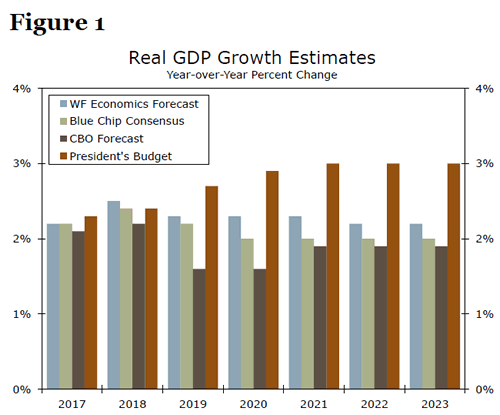
The economy’s long-run sustainable rate of economic growth is driven by three factors: labor, capital and total factor productivity (TFP). Given current demographic headwinds (boomers are leaving, not entering, today’s workforce), and a historically weak stretch for productivity growth, growth of 3 percent is a tall order. In her testimony before Congress earlier this month, Fed Chair Yellen said that 3 percent growth would be "something that would be wonderful if you could accomplish it," but conceded that in reality it "would be quite challenging."3 In our view, 4 percent plus would be nearly impossible. In this special report, we unpack the key drivers used in longrange forecasts and consider the scenarios under which 3 percent growth might be achieved.
In order to achieve sustained 3 percent GDP growth, the economy would need the unlikely occurrence of surging labor force growth like we saw in 1970s/1980s or the capital spending spree/technological innovations seen with the advent of the internet in the 1990s.
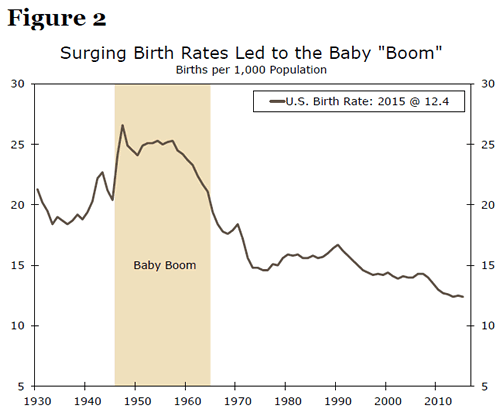
Why So Slow? Isn’t 3 Percent Just Average?
While it is true that real GDP growth has averaged 3.2 percent per year since 1950, that average is skewed by much higher growth rates in the early part of that period. For more than a generation, 3.0 percent real GDP growth has been much tougher to achieve on a sustained basis. Since 1970, average annual GDP growth has been 2.7 percent. Since 2000, it is just 1.9 percent.
Over the short-run, aggregate spending drives economic growth. It is from the demand-side that economists derived the well-known equation C+I+G+NX=GDP. Although economists measure the economy in this way, over the long run growth is driven by an economy’s capacity to produce goods and services. This is a somewhat tricky concept that is best illustrated by an extreme example. If tomorrow all U.S. consumers went out and drained their savings accounts completely, economic growth would surge. However, this surge would do nothing to raise the economy’s productive capabilities, and the increase in economic activity would quickly peter out.
As stated in the intro, it is labor force growth and the growth in the productivity of these workers that determines the sustainable growth rate for the economy. The latter half of this duo can further be divided into two drivers: capital (the physical tools utilized by the workers) and total factor productivity (the intangibles that affect output per hour worked, such as education or new innovations). Potential GDP has decelerated as both labor productivity and labor growth have slowed (Figure 3). Those brief periods when the economy was able to crank along at an above average pace were often made possible by one-off surges in one of the inputs (Figure 4).
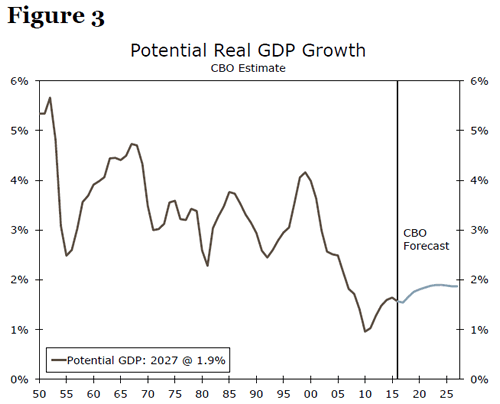
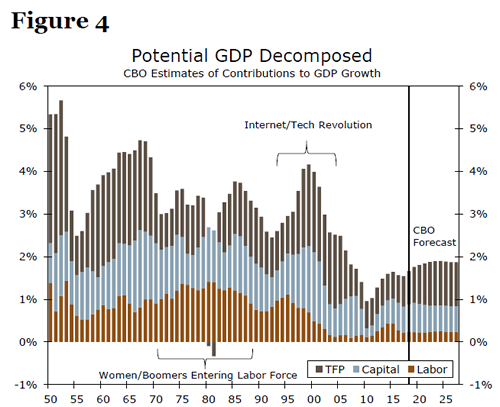
The red bars in Figure 4 illustrate the surge in the labor force that began in the 1970s as baby boomers and women entered the workforce in greater numbers. The blue and brown bars represent the growth of capital and TFP and show the surge that occurred in the second half of the 1990s as American businesses ramped up info-tech spending and embraced new technologies.
At present, there are no clear signals that these dynamics are likely to be repeated in the near term. In the rest of this report, we explore each of these dynamics in greater detail to determine what it would take to reach a sustainable growth rate of 3 percent.
Battling Demographic Headwinds
To achieve sustained economic growth of 3 percent solely through labor input, potential hours worked would need to expand at about 2.2 percent per year, holding the CBO’s capital and total factor productivity forecasts constant (Figure 5). This would be a rare feat in U.S. economic history, requiring potential labor hours growth in the neighborhood of the rates achieved during the period when mass inflows into the labor force occurred from baby boomers and women. The year-over-year percent change in the workforce is plotted in Figure 5 and illustrates the challenge in unmistakable terms.
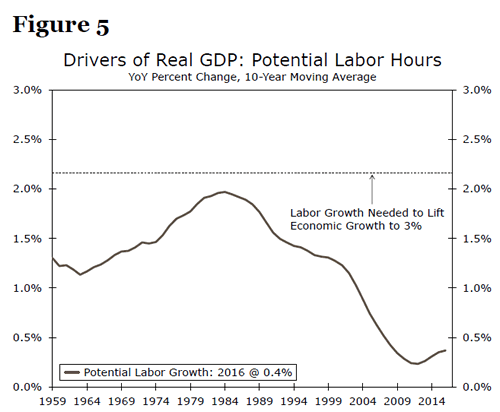
Such a dramatic rebound in the growth rate of the labor force would not only reverse a trenddecline that has been in place for more than a generation, it would also be at odds with underlying demographic trends and the aging of the population. Since 1997, the 55-and-over crowd has increased as a share of the labor force at the expense of younger workers (Figure 6). Notably, in 2003 the share of these older workers in the labor force surpassed that of 16-24 year-olds. Primeage workers (25-54 year-olds) are still the lifeblood of the labor force, but the graying of the American workforce exhibits a clear upward trend.
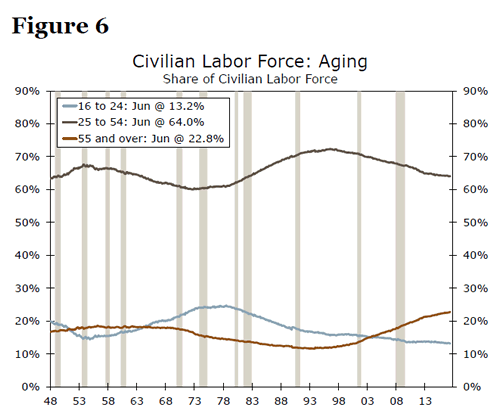
The fertility rate in the United States in 2016 was the lowest it has ever been. Even if incentives for boosting fertility were adopted today, there is a roughly 20-year lag before those measures bear fruit in terms of faster labor force growth. A liberalization of immigration policy could boost labor force growth more quickly, but this is likely a non-starter in the current political climate.
Labor Productivity Left to Pick Up the Slack
So, if labor force growth cannot be boosted in the near term, what about measures to boost capital and productivity? To achieve sustained potential GDP growth of 3 percent over the next decade through capital alone, potential capital growth would need to average about 5.5 percent, well above even the fastest historical potential growth rates (Figure 7). Similarly, to achieve potential GDP growth of 3 percent over the next decade through TFP growth alone, potential TFP growth would need to average approximately 2.1 percent, more than four times higher than the pace of actual TFP growth over the past year and much higher than has been achieved for most of the recent past (Figure 8).
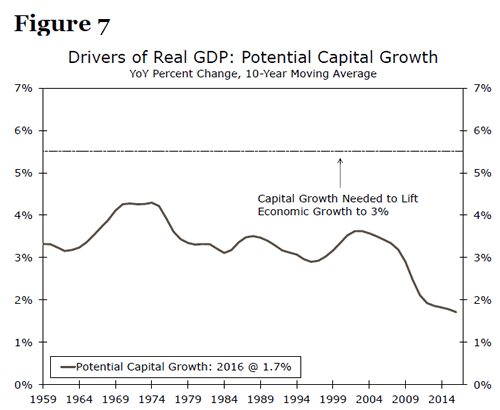
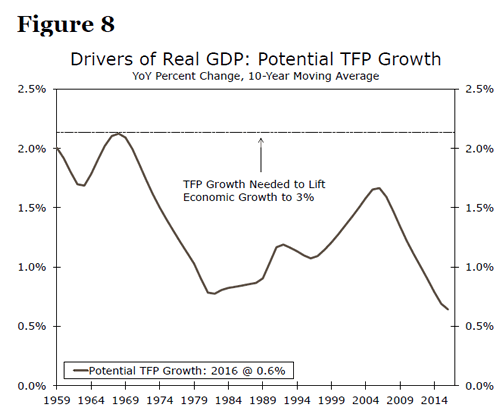
As it happens, capital spending in this cycle has been weak, though it is getting stronger. A slowdown in energy-related spending contributed to a run of four consecutive quarterly declines in real equipment spending last year. Prior to this period, we had never witnessed more than two consecutive quarterly declines outside of a recession. Equipment spending turned positive in the fourth quarter of 2016 and has now increased for three straight quarters. Business sentiment has improved in recent months, and core capital goods orders are firming as well, so we expect a modest improvement in capital spending, but not enough to drive the sort of capital growth we would need to hit 3 percent growth.
Total factor productivity has perhaps the most potential to boost growth, as growth in TFP flows through one-for-one to growth in potential GDP. The challenge with total factor productivity growth is that, among the three components, it is the most elusive. Increasing inputs such as capital and labor, while no easy feat, is at least straightforward. Increasing the efficiency with which those inputs create output, however, is a more daunting task. Developing more skilled workers through education is one potential avenue, but college enrollment rates have flat-lined after decades of rising. Fostering the conditions for entrepreneurship and innovation is another important step, but the steps necessary to do so are neither always clear nor easy. Perhaps the widespread use of artificial intelligence or some other major breakthrough is right around the corner, but the timing and extent of its economic impact would be huge question marks, and banking on this occurring is not much of an economic strategy from a policymaking perspective.
Wait Wait Wait: Can’t All These Things Improve at Once?
The above examples illustrate the challenge in achieving 3 percent potential growth by improving one input alone. However, at this point some of our more optimistic readers might be asking: what if all three drivers of potential growth increase at once? To illustrate what this might look like, we turn to the last time real potential GDP growth averaged 3 percent over a 10-year period. Figure 9 illustrates the average contributions to potential growth from labor, capital and TFP from 1997-2007, the last time this feat was achieved. This period saw robust total factor productivity and capital growth as businesses and individuals embraced computers and information technology. Over the next decade, potential total factor productivity growth would need to be approximately 68 percent faster than the CBO projects, or roughly 0.6 percentage points, while potential capital growth would need to be about 75 percent faster each year.
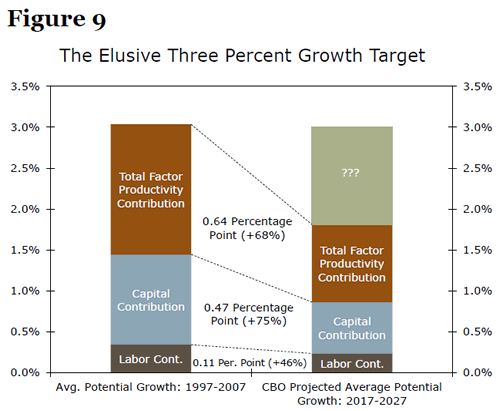
Ultimately, the key challenge is that labor and productivity often change at a glacial pace, and the current trend growth rates are historically slow. An optimist might say perhaps this means there is only room to go up from here. However, due to the long lead times needed for a change in these long-term factors influencing growth, such a low base today implies that even solid progress might not be enough to achieve robust growth of 3-4 percent. Furthermore, to achieve 3 percent growth, everything has to improve simultaneously. This is of course possible, but raising the pace of growth in labor, capital and TFP all at once is a tall task. As illustrated in Figure 10, there is little precedent for surging labor force and labor productivity growth occurring simultaneously over a 10-year period (Figure 10).
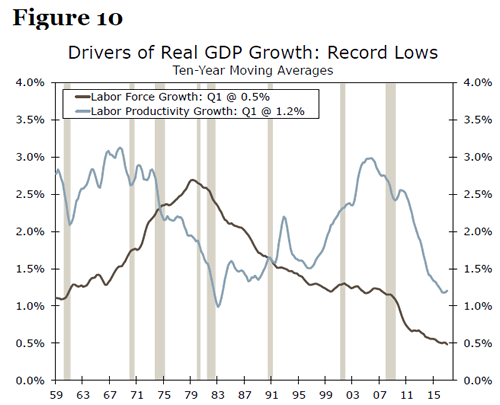
Conclusion
The economy’s long-run sustainable rate of economic growth is driven by three factors: labor, capital and total factor productivity. Our analysis considers what kind of growth it would take in any one of these factors individually or in combination to achieve 3 percent growth on a sustained basis. While we agree with Chair Yellen’s assessment that such a growth environment would be wonderful, it would also be very difficult to achieve and maintain.
In our assessment, the world’s largest economy can only grow at 3 percent on a sustained basis if one makes unrealistically rosy assumptions about the pace of labor force growth that would match the simultaneous arrival of women in larger numbers and the baby boomers’ entry into the workforce seen in the late 1970s/early 1980s. The 3 percent goal would also likely require a pace of capital spending like we witnessed with the capital spending spree of the 1990s.
None of this is to say that the economy could never grow at such a strong pace again, but past cycles have demonstrated that all three of these factors tend to change at a slow pace, which suggests long lead times before new policies could achieve the fleeting objective of 3 percent growth.












